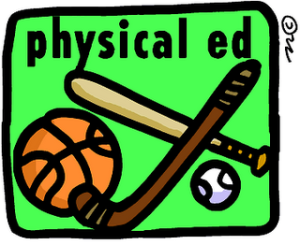 An article in the Chicago Tribune caught my attention this week regarding “Fat P.E.” At least that is what the kids at a suburban Illinois high school call it. Basically, the students are ability grouped according to results obtained in fitness testing. Those testing out at a high enough level are allowed to participate in team sports and other elective Physical Education classes. Students whose current levels of fitness do not meet the minimum fitness standards go into a fitness class that emphasizes personal fitness and allows them to get better at the fitness components that they are lacking. As they continue through the class, students can re-test and if their fitness levels get to the minimum standards, they can place out into another Physical Education class.
An article in the Chicago Tribune caught my attention this week regarding “Fat P.E.” At least that is what the kids at a suburban Illinois high school call it. Basically, the students are ability grouped according to results obtained in fitness testing. Those testing out at a high enough level are allowed to participate in team sports and other elective Physical Education classes. Students whose current levels of fitness do not meet the minimum fitness standards go into a fitness class that emphasizes personal fitness and allows them to get better at the fitness components that they are lacking. As they continue through the class, students can re-test and if their fitness levels get to the minimum standards, they can place out into another Physical Education class.
Obviously, you can get a visual of what happened. As one student said, “It was like a division of the fat kids and the thin kids.”
Let’s take a look a little deeper than the visual.
First, I see both sides of the fence with ability grouping. I have to say I am a fan in most areas, if it is done right. You are never going to get students that are exactly on the same level. There will still be opportunities to have peers “coach up” their classmates and differentiate learning. However, the one aspect that this program has in its favor, and the one thing that many ability grouped classes don’t allow, is the chance to test out and move up a level.
I know it is not feasible to have a first grader change classrooms every few months because all of sudden the light bulb goes on and they progress through curriculum at a rapid pace. However, why shouldn’t a student in upper elementary, middle, or high school be allowed to progress up or down a scale when their abilities show they have mastered the standards to a certain level? Aren’t we holding back some of our students that could really achieve at a high level? Over time, I have come to dismiss the argument against the “Bluebirds and Buzzards” classrooms. Ask any student who the “Bluebirds” are in their class and they can tell you. It is the same for the “Buzzards”.
Back to the “Fat P.E.” concept. From a Physical Education standpoint, I love this idea, but of course despise the student’s name for it. Don’t we all really need a certain amount of fitness in our lives? Even in elementary school, it is sometimes difficult for students with lower fitness levels to keep up with their classmates learning skills, games, and activities. I can differentiate the individual fitness activities for them, but it is really tough to make a game or activity “slow down” so they can reap the Physical Education benefits. Middle school and high school students should be able to achieve and maintain a certain level of personal fitness in order to move ahead to team and lifetime sports instruction. Not only will it enhance personal fitness levels, it will also let the students participate in the activities without their lack of fitness levels impacting learning.
We experimented with this approach at a middle school a few years ago. One of the teachers in the department approached me with the idea. Our administration agreed to experiment with the concept. We utilized the students’ Fitnessgram scores from the early parts of the school year to make the placements in the nine week course. The results were great. Students in that course knew why they were in there. The instructor led them through a variety of cardio, muscular strength/endurance, and flexibility sessions. Additionally, students received instruction in nutrition. They supported each other and encouraged their classmates to make better choices, be active, and eat a healthier diet. At the end of the nine weeks, not only did their fitness levels improve, but many lost weight. Obviously, some students were not happy to be placed in that class, however, many thanked the teacher at the end for improving their lives.
I don’t know if “Fat P.E.” will catch on, but I do think it is a concept worth investigating. If we can get a better name and remove any stigmas associated with it, the fitness levels of our students may increase. In turn, they should make better choices as adults and facilitate reversing the trend toward obesity.
[/fusion_builder_column][/fusion_builder_row][/fusion_builder_container]




